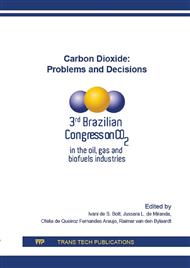[1]
J. E. Bara, D. E. Camper, D. L. Gin, R. D. Noble, Room-Temperature Ionic Liquids and Composite Materials: Platform Technologies for CO2 Capture, Accounts of Chemical Research, 43 (2010) 152-159.
DOI: 10.1021/ar9001747
Google Scholar
[2]
B. Belaissaoui, D. Willson, E. Favre, Membrane gas separations and post-combustion carbon dioxide capture: Parametric sensitivity and process integration strategies, Chemical Engineering Journal, 211 (2012) 122-132.
DOI: 10.1016/j.cej.2012.09.012
Google Scholar
[3]
R. Bounaceur, D. Wilson, E. Favre, Membrane processes for post-combustion carbon dioxide capture: A parametric study, Energy, 31 (2006) 2556-2570.
DOI: 10.1016/j.energy.2005.10.038
Google Scholar
[4]
A. Brunetti, E. Drioli, Y. M. Lee, G. Gabieri, Engineering evaluation of CO2 separation by membrane gas separation systems, Journal of Membrane Science, 454 (2014) 305-315.
DOI: 10.1016/j.memsci.2013.12.037
Google Scholar
[5]
U. Desideri, A. Paolucci, Performance modelling of a carbon dioxide removal system for power plants, Energy Conversion and Management, 40 (1999) 1899-(1915).
DOI: 10.1016/s0196-8904(99)00074-6
Google Scholar
[6]
D. Dortmund, K. Doshi, Recent Developments in CO2 Removal Membrane Technology, UOP LLC. (1999).
Google Scholar
[7]
L. A. El-Azzami, E. A. Grulke, Carbon Dioxide Separation from Hydrogen and Nitrogen by Falicitated Transport Swollen Chitosan Membranes, Journal of Membrane Science, 323 (2008) 225-234.
DOI: 10.1016/j.memsci.2008.05.019
Google Scholar
[8]
Global CCS Institute, The Global Status of CCS, Melbourne, Australia, 2014, pp.100-109.
Google Scholar
[9]
X. Z. He, M. B. Hagg, Hollow fiber carbon membranes: Investigations for CO2 capture, Journal of Membrane Science, 378 (2011) 1-9.
Google Scholar
[10]
Minh T. Ho, Guy W. Allinson, Dianne E. Wiley, Reducing the cost of CO2 capture from flue gases using membrane technology, Industrial & Engineering Chemistry Research, 47 (2008) 1562-1568.
DOI: 10.1021/ie070541y
Google Scholar
[11]
International Panel on Climate Change (IPCC), Special Report on Carbon Dioxide Capture and Storage, Cambridge University, 2005, pp.114-122.
Google Scholar
[12]
International Panel on Climate Change (IPCC), Working Group 1 Contribution to the IPCC fifth Assessment Report (AR5), Climate Change 2013: The Physical Science Basis, 2013, pp.3-23.
DOI: 10.1017/cbo9781107415416
Google Scholar
[13]
International Panel on Climate Change (IPCC), Working Group III Contribution to the Fifth Assessment Report of the Intergovernmental Panel on Climate Change, Cambridge University, 2014, p.70.
DOI: 10.1017/cbo9781107415416
Google Scholar
[14]
N. Lepaumier, D. Picq, P. L. Carrette, New Amines for CO2 Capture. I. Mechanisms of Amine Degradation in the Presence of CO2, Indusrial & Engineering Chemistry Research, 48 (2009) 9061–9067.
DOI: 10.1021/ie900472x
Google Scholar
[15]
S. P. Nunes, K. V. Peineman, Membrane Technology in the Chemical Industry, 2001, p.44, pp.54-55.
Google Scholar
[16]
R. Perry, Perry's Chemical Engineers' Handbook, 1999, pp.14-17.
Google Scholar
[17]
Information on http: /www. portalbrasil. net/indices_euro_dolar. htm.
Google Scholar
[18]
L. M. Romeo, I. Bolea, J. M. Escosa, Integration of power plant and amine scrubbing to reduce CO2 capture costs, Applied Thermal Engineering, 28 (2008) 1039-1046.
DOI: 10.1016/j.applthermaleng.2007.06.036
Google Scholar
[19]
D. W. Shin, S. H. Hyun, C. H. Cho, M. H. Han, Synthesis and CO2/N2 Gas Permeation Characteristics of ZSM-5 Zeolite Membranes, Microporus and Misoporus Materials, 85 (2005) 313-323.
DOI: 10.1016/j.micromeso.2005.06.035
Google Scholar
[20]
D. S. Silva, J. L. Medeiros, J. F. Nascimento, W. M. Grava, O. Q. F. Araújo, Technical and Economic Analysis of CO2 Capture from Natural Gas: Chemical Absorption Versus Membranes Permeation, Rio Oil & Gas Expo and Conference. (2014).
Google Scholar
[21]
M. Songolzadeh, M. Solemane, M. T. Ravanchi, R. Songolzadeh, Carbon Dioxide Separation from Flue Gases: A Technological Review Emphasizing Reduction in Greenhouse Gas Emissions, submitted to Scientific World Journal (2014).
DOI: 10.1155/2014/828131
Google Scholar
[22]
SRI Consulting Pep Report, Membranes Gas Separation Processes, Report 190 A. Menlo Park, California, (1990).
Google Scholar
[23]
E. Visser, C. Hendrik, M. Barri, M. J. Molvinik, G. Koeijer, S. Liljemark, W. L. Gallo, Dynamis CO2 quality recommendations, International Journal of Greenhouse Gas Control, 2 (2008) 478-484.
DOI: 10.1016/j.ijggc.2008.04.006
Google Scholar
[24]
Z. Wang, M. Fang, Y. Pan, S. Yan, Z. Luo, Amine-based absorbents selection for CO2 membrane vacuum regeneration technology by combined absorption-desorption analysis, Chemical Engineering Science, 93 (2013) 238-249.
DOI: 10.1016/j.ces.2013.01.057
Google Scholar


